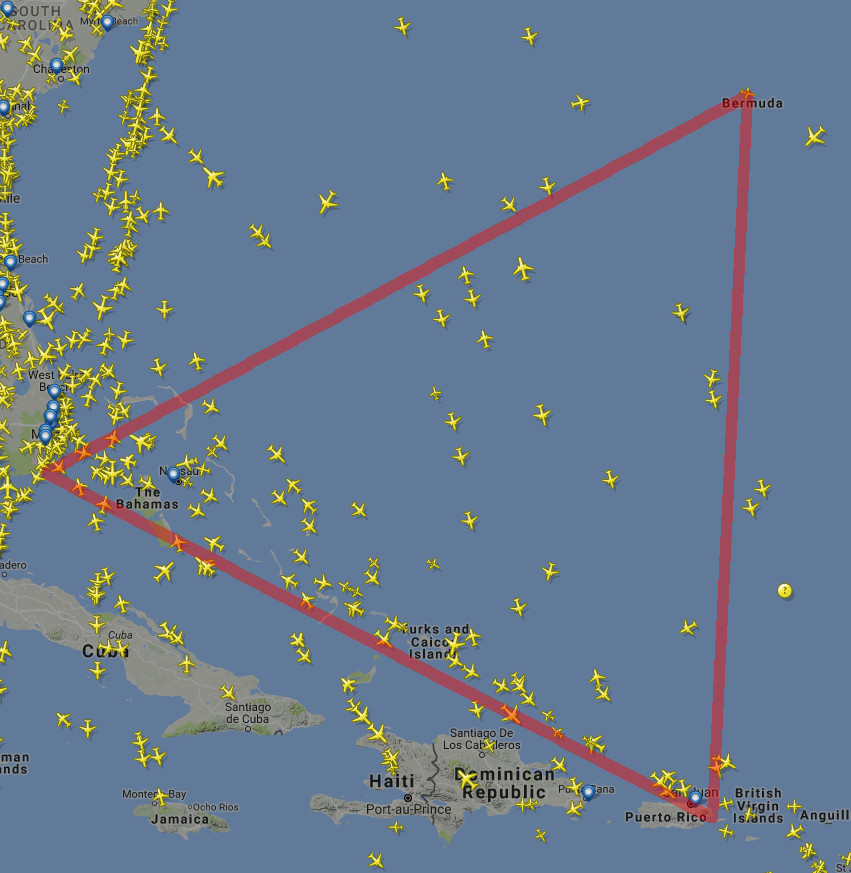It’s a question that has lingered in the air for decades, fueled by tales of mysterious disappearances and unexplained phenomena: do planes actually fly over the Bermuda Triangle? A quick glance at real-time flight tracking data immediately reveals the answer. Websites like Flightradar24 clearly demonstrate that the Bermuda Triangle is far from an aviation no-fly zone. In fact, this area sees a significant amount of air traffic daily.
The Bermuda Triangle: A Busy Airspace
The region defined by the Bermuda Triangle, stretching between Florida, Bermuda, and Puerto Rico, is a hub of air travel. The southern portion of this triangle is particularly busy, serving as a primary air corridor connecting Florida to Puerto Rico and numerous other destinations in the Caribbean. Furthermore, the broader area is incorporated into flight paths originating from the East Coast of the United States heading towards the Caribbean islands and South America. This makes the Bermuda Triangle not an area to be avoided, but rather a routinely traversed and essential part of global air travel routes.
Debunking the Bermuda Triangle Mystery
The enduring mystique of the Bermuda Triangle often suggests it’s a uniquely dangerous place, prone to causing inexplicable aircraft disappearances. However, substantial evidence contradicts this notion. Statistical analysis reveals that the Bermuda Triangle does not exhibit a significantly higher rate of incidents compared to other heavily trafficked regions around the world. Given its strategic location and the sheer volume of air traffic it accommodates, it’s statistically expected to witness a number of incidents, much like any other busy aviation corridor.
 Flight paths over the Bermuda Triangle as seen on Flightradar24
Flight paths over the Bermuda Triangle as seen on Flightradar24
Image: A snapshot from Flightradar24 showcasing the density of flight routes crossing the Bermuda Triangle, effectively illustrating that planes routinely fly over this area.
Modern Aviation Technology and Safety
Advancements in aviation technology have dramatically reduced the risks associated with air travel, even over areas with historical navigational challenges. Modern aircraft rely on sophisticated systems monitored by Air Traffic Control (ATC). Any anomalies in magnetic fields or radio navigation aids like VOR or GPS are meticulously surveyed and documented on navigation charts, ensuring pilots are well-informed. Moreover, the accuracy of weather forecasting, enhanced by long-range radar and weather satellites, provides pilots with crucial information to navigate safely.
Historical Perspective on Aviation Incidents
Examining records of aviation incidents attributed to the Bermuda Triangle reveals a pattern. The majority of reported incidents occurred in the 1960s and earlier eras, a time when navigational technology was less advanced. More recent air incidents in the area are infrequent and generally attributed to common causes such as general aviation accidents, which are unfortunately not uncommon globally, or diversions due to technical malfunctions – events that can happen anywhere in the world, not just over the Bermuda Triangle.
Conclusion: Routine Flights, Not Mystery
Despite lingering public fascination with the Bermuda Triangle’s mythical dangers, the reality is that planes routinely fly over this area without incident. The notion that airlines or pilots avoid it is simply untrue. The Bermuda Triangle is a busy part of the global airspace, and while apprehensions may persist for some, the data and expert analysis indicate that these concerns are not substantiated by any abnormal rate of incidents. It is, in essence, just another part of the sky, regularly navigated by countless flights every day.